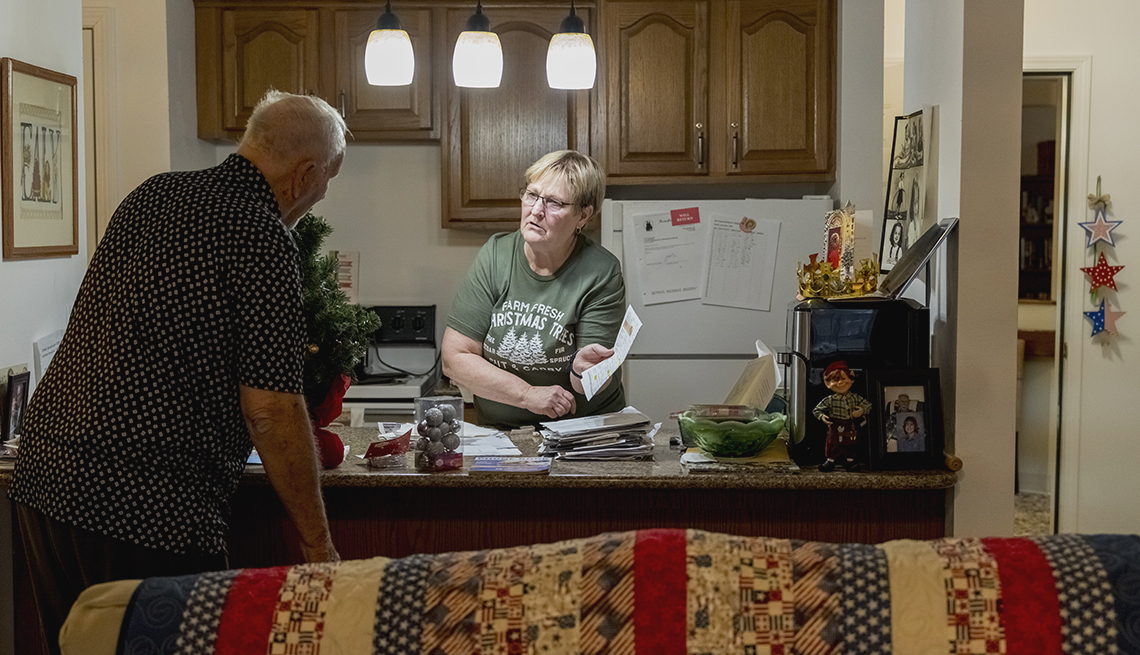AARP Hearing Center

After her uncle broke his neck in a 2020 car accident and could no longer drive, Jean Bohnhoff commuted 200 miles every week from her home in Effingham to care for him and his wife in suburban Chicago.
When the trips became untenable, she moved Chuck and Carole Ealy into her home. At the time, Carole was showing early signs of Alzheimer’s disease.
“I just kind of feel like family takes care of family,” says the 70-year-old Bohnhoff, a former director of the Illinois Department on Aging who still works in the aging field. “I love my uncle like he was my own father.”
An AARP volunteer, Bohnhoff still cares for her uncle—now 85 and in an assisted living community—as well as a second uncle, taking them to appointments and helping them with other daily needs. (Carole died in 2021.)
With the 2024 legislative session beginning in early January, AARP Illinois is urging state lawmakers to enact a tax credit for family caregivers like Bohnhoff who incur out-of-pocket expenses. A bill introduced last year by Rep. Anna Moeller (D-Elgin) would give eligible caregivers a non-refundable tax credit of up to $1,500 for certain expenses, including home modifications, home care aides and transportation costs. Single caregivers with an adjusted gross income of less than $75,000 ($150,000 for couples filing jointly) would be eligible.
“We believe this is really a step in the right direction to offer the support our family caregivers need,” says Lori Hendren, AARP Illinois’ senior associate state director for advocacy and outreach.
Several other states—including North Dakota, Missouri and Oklahoma—offer some version of a caregiver tax credit. Moeller says her bill’s significant price tag prevented it from advancing previously, amid competing funding priorities.
But Hendren says AARP is working with Moeller on a new draft that would change the scope of the bill to boost its prospects. She says the revisions would lower the amount of the tax credit and narrow eligibility from adults over 18 to those over 50. Those changes should slash the bill’s cost.
An essential role
The pressure on Illinois’ family caregivers is likely to grow as the state’s population ages. Proponents of a tax credit say family caregivers help hold down the cost of Medicaid, the joint federal-state government program that pays for, among other things, nursing home care for low-income Americans.
Caregiving can involve everything from making meals to attending medical appointments. Thirty-six percent of U.S. caregivers characterize their situation as highly stressful, according to a 2020 report from AARP and the National Alliance for Caregiving.
Bohnhoff, who now works at the assisted living center where both her uncles live, says she has never tallied up the costs of caring for them or her aunt. She says a tax credit would be a good step forward in helping ease the burden of caregivers.
“I know some caregivers that have had to cut back on their [work] hours ... because it takes so much in order to help with their loved ones,” she says.

A push for equity
AARP Illinois also hopes for action in the 2024 legislative session on a measure that would require equity between two state initiatives—the Community Care Program and the Home Services Program—that both provide in-home services to eligible Illinois residents to help them avoid institutional care. The Community Care Program serves low-income people who are 60-plus and might otherwise need nursing home care, while the second program serves people with disabilities who are under 60.
Hendren says there are disparities in how the two programs work. For example, a Home Services client diagnosed at 59 with Alzheimer’s disease may get help from a home health aide or an occupational therapist, while a person who is 60 at the time of diagnosis cannot get that assistance from Community Care.
Making all services available to older people “will keep people in their home and community longer,” she says. That in turn will help “save taxpayer dollars, compared to premature placement in nursing homes.”
Mary Dieter, a freelance journalist, spent two decades covering Indiana state policy and politics for The Courier Journal of Louisville, Kentucky.
For more on caregiving:































































